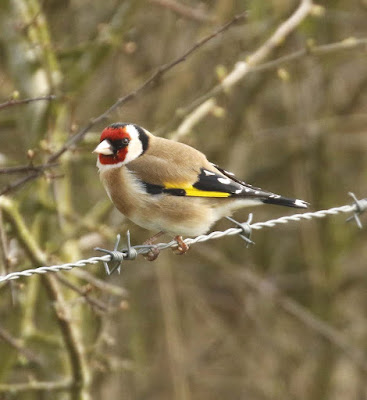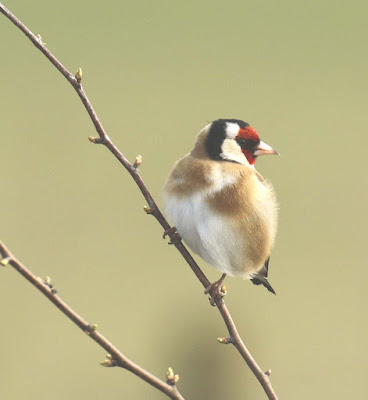The clocks went forward last night and as a consequence of losing an hour of sleep I sat even more drowsily than usual on the side of the bed drinking a cup of tea and mulling over whether to go and see an Iberian Chiffchaff that had overshot its normal destination in southern Europe by some margin and was now singing its strange song, so very different to that of our normal Common Chiffchaff, in a small park at Yate near Bristol.
Whilst reflecting on this and trying to get myself together I looked out from our bedroom window at a view that never ceases to inspire, where the undulating contours of the southern Cotswolds stretch away into the distance. Above, the early morning cloudless sky was being crossed with the vapour trails of many jet aircraft, arriving from the west and heading south, no doubt to land at Heathrow Airport. Some of the trails were pencil thin, like a continuous shooting star, and you could see the shining aircraft at the head of the vapour but other trails were dissipating and broadening into amorphous, thick fluffy bands from planes that had passed over previously. I inwardly shuddered as for many years I too travelled the world as a salesman on just such aircraft and could imagine the passengers on the jets above, tired, dishevelled and weary from sitting uncomfortably for hours, maybe drinking too much and enduring the noise and artificially maintained atmosphere in the confines of what is no more than a metal tube hurtling through the air at hundreds of miles an hour, no matter how sophisticated or glamorous a gloss you try to put on it.
My thoughts went back to the Iberian Chiffchaff which had also travelled a very long way, but as a natural, instinctive part of its life with nothing more than some feathers and an internal compass that had gone slightly awry to allow it to accomplish its journey.The contrast at this moment could not have been more graphically illustrated.
I resolved to go and see the Iberian Chiffchaff, buoyed by the prospect of another glorious day ahead promising full sunshine and the fact it was not too long a drive to Yate. Iberian Chiffchaffs are recorded annually in Britain, usually in April and May and can and do turn up virtually anywhere when they do stray too far north. They are normally found in the French Pyrenees and south through Portugal and Spain to North Africa where they are restricted to northwest Morocco, northern Algeria and northwest Tunisia. Forty seven have been recorded in Britain up to the end of 2015 with normally one or two turning up each year, although the records seem to be increasing of late, culminating in 2015 when a pair successfully bred on the Gower in Wales, raising seven young. This, so far, is the only record ever of this species breeding in Britain and truly remarkable, in that a male and female of the same species should find each other so far out of their normal range, let alone pair and successfully breed. Some vagrant Iberian Chiffchaffs are only present for a day but others tarry longer, for up to a week and sometimes for more than a month, the longest staying for 83 days in 2013.
So similar looking to our Common Chiffchaff are they, that it is considered they can only be safely identified by their call and by their very different song which is a series of variable notes delivered at speed with a trill at the end and is shorter in duration and quite unlike the monotonous two note song of our Common Chiffchaff.
There are subtle plumage differences too, which make it look slightly brighter, somewhere between 'our' Common Chiffchaff and a Willow Warbler. Its supercilium is longer and yellower and the undertail coverts are also yellow whereas the rest of the underparts are almost white. Its bill is also finer, its tail looks longer and the legs are paler and certainly not black, but all these identification pointers can only be seen with close and prolonged views from a singing bird which is what I hoped to get this morning.
The drive to Yate was accomplished with ease on a quiet Sunday morning with roads free of traffic and just after 9.30 I was parking the car in Kingsgate Park, an unassuming, small suburban park surrounded on all sides by housing. Like many similar, the park must have been part of a large estate in long past times before it was sold and engulfed by housing as there is a massive stately home that was formerly called Stanshawe Court on the park's perimeter and the current park and lake were obviously part of the formal gardens that went with the house in grander times.
The Iberian Chiffchaff was frequenting a narrow island of small willow and sallow trees, hawthorns, bushes, ivy and brambles, surrounded by water allegedly containing Great crested Newts and which is separated from the main lake by a tarmac footpath. This area is apparently deliberately kept wild as a nature reserve and managed by Avon Wildlife Trust. The rest of the park and the greater part of the lake is maintained as a recreational facility for the surrounding residents and visitors, with expanses of mown grass, flower beds, swings and play areas for children and the main lake is also used by a model boat club at various times.
I stood with a half dozen other birders on a gravel track and looked over the narrow stretch of water to the edge of the island and immediately heard the Iberian Chiffchaff singing and not very long afterwards saw it feeding and singing in the tangle of twiggy vegetation spilling down the bank of the island into the water. It was difficult viewing as standing on the track we had to look through or over an impenetrable hedge of small ivied hawthorns, and brambles that grew quite high and partially obscured one's view.
The chiffchaff kept low on the opposite bank as it was sheltered from the strong wind so this made it even more difficult to see. Eventually I found a small gap that allowed me to get down onto the bank beyond the boundary hedge and stand by the water's edge and my view across to the island was then much better.
The chiffchaff was singing constantly and I could see it well as it mainly kept to a small sheltered area of trees, bushes and brambles that were in the sun almost opposite me. Occasionally it would move fifty or so metres along the island bank but always returned to its favoured small area of trees and bushes. An added difficulty was the fact there were at least two Common Chiffchaffs feeding in the same area but they were also singing so if there was any doubt, once they sang their identity was confirmed but you had to be careful when they were silent and one or two birders did mis-identify the bird they were looking at until it sang.
This individual, over the period of time I observed it, showed many of the generally accepted diagnostic features of its species. The brighter colouring compared to the Common Chiffchaffs caused by the greener upper-parts. the yellower saturation on its face and undertail coverts as well as the almost white belly became increasingly obvious as I got more and more views of it. Examining the photos I took of it the finer bill, longer tail and wing point and paler legs were also plain to see.
It was constantly on the move, singing and feeding with non stop enthusiasm and occasionally hassled by a pugnacious Robin but for the most part it was left untroubled. It indulged in brief, high speed aerobatic sorties out over the water chasing an insect but generally preferred to stay in cover in the dense tangles of vegetation on the bank of the island.
The morning progressed and I stood quietly on the bank and awaited opportunities to see it and finally satisfied after a couple of hours of intermittent close views, I made my way back to the car but not before stopping at The Cakery, a cafe located in the former stables of the stately home and serving mouthwatering cakes of every possible description. I exercised supreme restraint and restricted myself to a skinny latte and a large chunk of Tiffin that set me up nicely for the hour's drive home.
So similar looking to our Common Chiffchaff are they, that it is considered they can only be safely identified by their call and by their very different song which is a series of variable notes delivered at speed with a trill at the end and is shorter in duration and quite unlike the monotonous two note song of our Common Chiffchaff.
 |
| Iberian Chiffchaff |
The drive to Yate was accomplished with ease on a quiet Sunday morning with roads free of traffic and just after 9.30 I was parking the car in Kingsgate Park, an unassuming, small suburban park surrounded on all sides by housing. Like many similar, the park must have been part of a large estate in long past times before it was sold and engulfed by housing as there is a massive stately home that was formerly called Stanshawe Court on the park's perimeter and the current park and lake were obviously part of the formal gardens that went with the house in grander times.
The Iberian Chiffchaff was frequenting a narrow island of small willow and sallow trees, hawthorns, bushes, ivy and brambles, surrounded by water allegedly containing Great crested Newts and which is separated from the main lake by a tarmac footpath. This area is apparently deliberately kept wild as a nature reserve and managed by Avon Wildlife Trust. The rest of the park and the greater part of the lake is maintained as a recreational facility for the surrounding residents and visitors, with expanses of mown grass, flower beds, swings and play areas for children and the main lake is also used by a model boat club at various times.
 |
| Looking over to the narrow island which is a Nature Reserve The Iberian Chiffchaff frequented the scrub along the bank of the island |
The chiffchaff kept low on the opposite bank as it was sheltered from the strong wind so this made it even more difficult to see. Eventually I found a small gap that allowed me to get down onto the bank beyond the boundary hedge and stand by the water's edge and my view across to the island was then much better.
 |
| The last three images above show three supposed diagnostic plumage features The long, broad and yellowish supercilium, the yellow undertail coverts and the almost white belly. Note also the fine bill |
This individual, over the period of time I observed it, showed many of the generally accepted diagnostic features of its species. The brighter colouring compared to the Common Chiffchaffs caused by the greener upper-parts. the yellower saturation on its face and undertail coverts as well as the almost white belly became increasingly obvious as I got more and more views of it. Examining the photos I took of it the finer bill, longer tail and wing point and paler legs were also plain to see.
It was constantly on the move, singing and feeding with non stop enthusiasm and occasionally hassled by a pugnacious Robin but for the most part it was left untroubled. It indulged in brief, high speed aerobatic sorties out over the water chasing an insect but generally preferred to stay in cover in the dense tangles of vegetation on the bank of the island.
















































